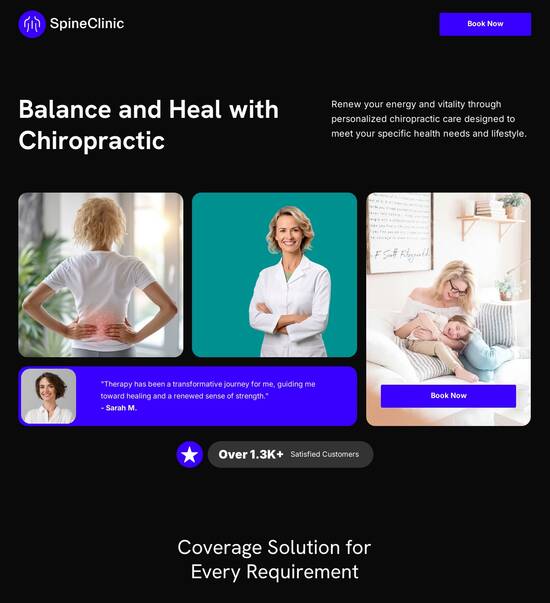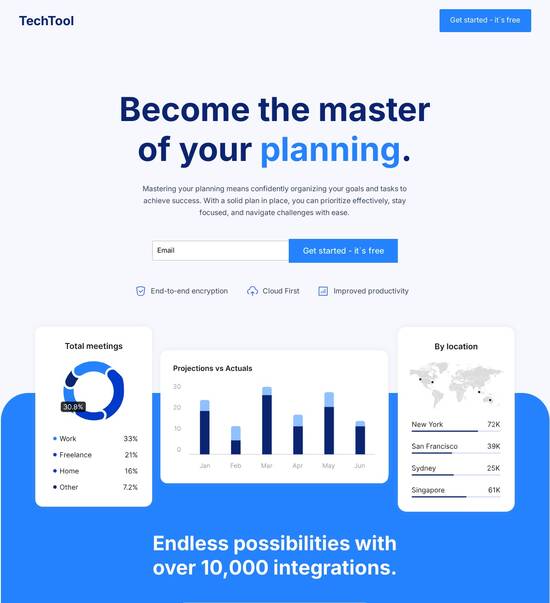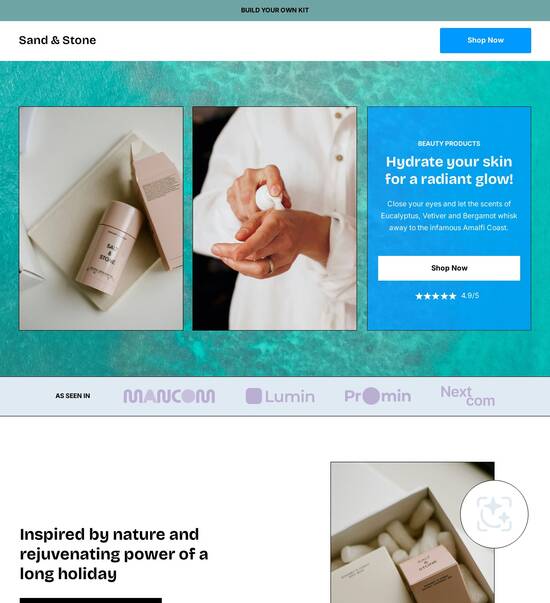
Onboarding page template for Data Analytics
Explore Similar TemplatesAbout template
Making landing pages is easy with Instapage. Find your onboarding page template for Data Analytics and easily polish it with our powerful editor.
Recommended templates

Easy to build without coding
With the intuitive drag-and-drop builder, anyone on your team can create high-converting pages without any knowledge of code or design. Make enhancements to your landing page with custom widgets using Javascript, HTML/CSS, or third-party scripts.

Multiple layouts for any industry and goal
Select from 500+ landing page layouts built to boost conversions across industry-specific scenarios. Customize them by adjusting fonts, adding images, and generating on-brand content with the AI assistant. Quickly scale with Instablocks® and Global Blocks that you can save, reuse, and update globally.

Loads fast and looks polished on any device
Every template is responsive, which means they present professionally on any device and load blazingly fast with our Thor Render Engine. You can also power them up with Google AMP technology to deliver an unparalleled mobile experience and drive higher conversions.

Robust analytics & experimentation
Get real-time updates and reporting across all your devices, showing the number of visitors, conversions, cost-per-visitor, and cost-per-lead. Launch AI-powered experiments, run A/B tests, and use heatmaps to analyze user behavior, then optimize your landing page to maximize conversions.







Easy to build without coding
With the intuitive drag-and-drop builder, anyone on your team can create high-converting pages without any knowledge of code or design. Make enhancements to your landing page with custom widgets using Javascript, HTML/CSS, or third-party scripts.
Multiple layouts for any industry and goal
Select from 500+ landing page layouts built to boost conversions across industry-specific scenarios. Customize them by adjusting fonts, adding images, and generating on-brand content with the AI assistant. Quickly scale with Instablocks® and Global Blocks that you can save, reuse, and update globally.
Loads fast and looks polished on any device
Every template is responsive, which means they present professionally on any device and load blazingly fast with our Thor Render Engine.
Robust analytics & experimentation
Get real-time updates and reporting across all your devices, showing the number of visitors, conversions, cost-per-visitor, and cost-per-lead. Launch AI-powered experiments, run A/B tests, and use heatmaps to analyze user behavior, then optimize your landing page to maximize conversions.
All the features you need to build data onboarding checklist
Explore more featuresLearn how to build business analyst onboarding form
FAQs
Leading the way in building high-performing landing pages





An onboarding page template for data analytics professionals
Creating an onboarding page is essential for data analytics professionals to ensure a smooth transition into your services. Instapage offers a robust landing page setup that helps organizations accelerate their marketing campaigns while maximizing returns on investment. Today's marketing landscape necessitates efficient customer education and orientation, especially for data analytics services.
Why choose an onboarding page template for data analytics?
An onboarding page template tailored for data analytics professionals provides a structured approach for engaging new users. By incorporating intuitive design elements and clear messaging, businesses can effectively guide new clients through their data analysis capabilities. Here’s why it's crucial to utilize such templates:
- Streamlined User Experience: A well-designed onboarding page simplifies the user journey, making it easy for new clients to understand the services offered.
- Improved Engagement: Engaging visuals and concise content keep users interested, ensuring they grasp essential tools without feeling overwhelmed.
- Higher Conversion Rates: Effective onboarding pages lead to increased user adoption of data analytics tools, ultimately boosting ROI.
Step 1: Customize your onboarding template
Begin by selecting an appropriate template that aligns with the unique aspects of your data analytics offerings. Instapage's extensive library provides a multitude of options designed specifically for this purpose.
Step 2: Add compelling content and visuals
Next, enhance your template with high-quality images and personalized messages tailored to your target audience.
- Use dynamic text replacement to meet specific audience personas, ensuring relevance and engagement.
- Integrate interactive elements such as infographics or visuals that summarize complex data effectively.
- Implement clear and concise calls to action (CTAs) to guide user interaction.
Step 3: Optimize and test your onboarding page
Once you've set up the content and visuals, make sure to run A/B tests using Instapage’s optimization tools. This will help you identify which variations resonate best with your audience.
- Monitor user behavior through heatmaps to understand how visitors interact with your onboarding content.
- Optimize based on conversion metrics, adjusting elements until you find the most effective design and messaging.
- Continuously gather user feedback to refine and enhance the onboarding experience.
In conclusion, effectively utilizing an onboarding page template for data analytics professionals allows organizations to create a supportive ecosystem for new users, maximizing user retention and satisfaction.
Take the first step towards enhancing your onboarding experience with Instapage. Explore our template library today and start engaging your data analytics clients with confidence!
People also ask about Onboarding page template for Data Analytics professionals
Onboarding page template for data analytics professionals
The significance of a tailored onboarding experience
Onboarding plays a crucial role in integrating new employees into the workplace, especially in specialized fields like data analytics. For data analytics professionals, the onboarding process must be customized to meet their specific needs, which often differ from traditional roles. Their expertise typically involves not just technical skills but also collaboration across various departments, making it vital for them to understand broader organizational goals from the outset. A successful onboarding experience can foster a sense of belonging and purpose, greatly enhancing employee engagement right from their first day.
Moreover, onboarding is closely linked to the company culture and can significantly influence employee retention rates. Companies with effective onboarding processes experience 82% higher employee retention rates, according to recent studies. By aligning onboarding with company values and providing comprehensive support, organizations can enhance employee satisfaction and loyalty. This competitive advantage is especially important in the tech industry, where talent acquisition and retention are paramount for sustainable growth.
Crafting the perfect onboarding page: key components
A well-designed onboarding page serves as a welcoming guide for new data analytics hires. It begins with an engaging overview that welcomes new recruits. A warm message can create a positive first impression, encouraging new hires to feel valued and excited about their roles. Within this section, it’s essential to introduce the organization’s mission, vision, and core values, which can help shape their understanding of company culture and motivate them to contribute meaningfully.
Next, the onboarding page should detail expectations specific to the role of a data analytics professional. Clearly outlining their specific duties helps set a solid foundation for success. Additionally, it's crucial to highlight the key performance indicators (KPIs) they will be evaluated against and any project timelines they need to adhere to. This transparency allows new hires to align their initial efforts with what is expected of them and facilitates smoother integration into their teams.
Preboarding process: setting the stage for success
The preboarding process can significantly enhance the onboarding experience by addressing initial jitters and fostering early engagement. Preboarding activities help ensure that new hires feel prepared when their start date arrives. A preboarding checklist should include tasks such as setting up equipment, creating user accounts, and introducing them to essential team members. Engaging new hires before their first day enables them to transition smoothly into their roles and fosters a sense of belonging even before they officially join the team.
Equipment setup: Ensure all necessary hardware and software are ready for first-day use.
Account creation: Establish access to email, internal communication tools, and project management software.
Documentation: Provide access to important onboarding documents such as the NDA, tax forms, and organizational guidelines.
Informative resources: Share resources on tools and software libraries the new hire will utilize.
Designing an engaging onboarding page template
Creating a user-friendly onboarding page is essential to ensure that new hires can navigate their onboarding experience with ease. Key design principles include clarity and usability; the layout should be intuitive, allowing new hires to find relevant information effortlessly. Customizing the onboarding page to reflect your company’s brand identity not only reinforces brand visibility but also fosters a sense of belonging among new employees.
Moreover, integrating multimedia elements can significantly enhance learning and engagement. Videos from leadership or team members can provide insight into the company culture and expectations. Interactive components like quizzes and polls can help reinforce training material, making the onboarding process not only informative but also engaging. By utilizing these strategies, companies can create a comprehensive onboarding experience that enhances retention and promotes productivity.
Essential policies and procedures for data analytics onboarding
An essential aspect of onboarding is familiarizing new hires with company policies. It is vital for data analytics professionals to understand the organizational framework, including compliance and data governance specific to analytics. Synthesizing critical company policies into easily digestible formats can help ensure new employees grasp important guidelines quickly, which can mitigate potential compliance issues later on.
In addition to company policies, new hires should be introduced to the analytical tools and technologies used within the organization. Providing an overview of analytical tools such as SQL, Python, and Tableau allows new employees to become comfortable with the frameworks they will be working within. Describing the documentation and workflows specific to data projects can further assist them in integrating effectively into their roles and contributing to team objectives.
Employee information form: gathering key data for HR work
An employee information form is a crucial component of the onboarding page, as it gathers essential data needed for HR processes. This form should include required personal and professional information that ensures compliance with company regulations. Additionally, collecting information relevant to their data analytics capabilities, such as specific skills and previous experience, enables HR to tailor support and development opportunities effectively.
It's equally critical to implement best practices for data privacy and security during this information-gathering phase. Employees must be informed of how their data will be handled and protected, ensuring adherence to data protection policies. Communicating these policies clearly can help alleviate concerns and build trust, fostering a secure onboarding environment.
Structured onboarding processes: a step-by-step plan
A structured onboarding process is essential for guiding new hires through their initial days, weeks, and months within the organization. Mapping out a clear timeline can help both new employees and their managers stay on track. For example, the first day should focus on orientation activities and introductions to team members, while the first week can integrate more in-depth training related to their specific role. Month one might be centered around initial projects, allowing them to begin contributing to team objectives.
Day 1: Complete orientation and introductions.
Week 1: Engage in technical training and team meetings.
Month 1: Participate in project work under mentorship.
Furthermore, establishing support structures like mentorship and buddy programs can enhance the onboarding experience. Pairing new hires with experienced team members facilitates knowledge transfer and promotes a more comfortable transition. This supportive environment can make a significant difference as new recruits navigate their new roles, ultimately enhancing their job satisfaction and productivity.
Measuring the effectiveness of onboarding programs
Evaluating the effectiveness of onboarding programs is fundamental in refining the onboarding page template. Gathering metrics of success, such as feedback surveys, can provide insights into new hire satisfaction and help identify areas for improvement. These surveys can cover various topics, from the clarity of provided information to the overall onboarding experience, ensuring a comprehensive evaluation of the program’s impact.
Feedback surveys: Assess new hire satisfaction and onboarding experience.
Performance analysis: Examine productivity and progression after onboarding.
Additionally, organizations should use data-driven insights to adjust onboarding templates continuously. By monitoring relevant metrics and refining processes based on feedback, HR can adapt to the unique needs of analytics professionals, ensuring the onboarding experience evolves and remains effective.
Building a culture of continuous learning and development
Fostering a culture of continuous learning can enhance the onboarding experience significantly. Companies should promote ongoing training opportunities, allowing data analytics professionals to keep their skills current. This can include access to webinars, workshops, and online courses tailored to the specific analytics tools and techniques relevant to their roles. Encouraging lifelong learning can greatly improve employee satisfaction and retention, benefiting the organization as a whole.
Moreover, onboarding can serve as a foundation for reinforcing company culture. Celebrating successes and emphasizing team engagement from day one can create a cohesive work environment. Encouraging cross-departmental collaborations on projects not only promotes relationship building but also enriches the overall performance of the analytics team, driving a unified organizational culture centered on shared goals and collaboration.
Future trends in onboarding for data analytics professionals
As the workplace evolves, so too must onboarding practices. The rise of remote onboarding presents new challenges and opportunities for organizations recruiting data analytics professionals. Adapting to these new norms requires best practices that focus on building connections among dispersed teams. This could involve utilizing videoconferencing tools for virtual meet-and-greet sessions or fostering online communities that bridge the gap between physical distances.
Additionally, the future of onboarding may see an increase in the application of AI and automation, streamlining processes and improving efficiency. Organizations must prepare to integrate these technologies into their onboarding strategies, ensuring they remain competitive in talent acquisition. By staying ahead of trends, companies can cultivate a resilient onboarding process that attracts and retains the best data analytics talent.
Ready to skyrocket conversions?
Supercharge your ad campaigns with high-performing landing pages
Get started














